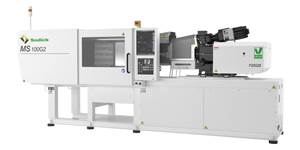'Soft-on-Soft' Is Newest Option In Soft-Touch Molding
It's hailed as a breakthrough for soft-touch injection molding: Collaborative efforts by three companies have resulted in the commercialization of an SEBS-based TPE vehicle handle in which a very soft (28 Shore A) surface layer is coinjected onto a substrate of a firmer—but still soft and rubbery—60 Shore A compound.
It's hailed as a breakthrough for soft-touch injection molding: Collaborative efforts by three companies have resulted in the commercialization of an SEBS-based TPE vehicle handle in which a very soft (28 Shore A) surface layer is coinjected onto a substrate of a firmer—but still soft and rubbery—60 Shore A compound. This "soft-on-soft" molding opens the door to new design options that were thwarted by previous limitations in materials and molding techniques.
The partners say that to their knowledge, all of the rapidly multiplying "soft-touch" applications in handles, grips, buttons, and knobs have been "soft-on-hard" structures. In these applications, a 60 Shore A thermoplastic elastomer is typically coinjected onto a rigid polypropylene or ABS substrate using twin-shot molding. The arrival of soft-on-soft capability means that designers of soft-touch parts can now differentiate products further by tapping a broader range of softness.
The molder of the breakthrough soft-on-soft TPE handle is Slatebond in Corsham, Wiltshire, U.K., which used a pair of Evoprene G compounds from U.S.-based AlphaGary Corp. The compounds were based on Kraton G SEBS resins supplied by Kraton Polymers. A new-generation grade with enhanced flow properties was used for the super-soft surface layer. Slatebond says it can make parts as soft as 15 Shore A hardness.
According to Slatebond's commercial manager, Adrian Mumford, its variable-softness handle puts end-users in the "best of all worlds." He says the surface softness prevents hand blisters, while the firmer substrate resists abuse and chemicals. Slatebond's design replaces an existing vehicle handle of a 60 Shore A SEBS that was slipped onto a rigid handle.
Soft-on-soft challenge
Previous barriers to soft-on-soft molding included a tendency for the pressures of injection molding to deform soft substrates. Strong adhesion between different soft TPE materials was also hard to achieve. Derek Fraser, AlphaGary's global ´óĎó´«Ă˝ manager, compares the problem to attempting to stick a stamp onto an envelope that is lying on a soft pillow. The challenge is especially difficult when it involves a thin-wall part. Fraser says the handle made by Slatebond consists of a 1 mm-thick, softer surface layer overmolded on a 3-mm substrate.
Fraser says one key to the solution was adapting the hot-runner and gating design in the tool previously used to make the single-hardness, 60 Shore A handle. Equally important was the special high-flow SEBS resin developed by Kraton for the 28 Shore A compound. That resin's easier flow helped prevent voids at the soft-soft interface. It also minimized knit line formation and ensured good adhesion of the soft layers, according to Fraser.
Exploring new territory
The partners are exploring potential for soft-soft design in additional applications. They argue that if the concept works for a vehicle handle, it can also be used for numerous other handles and grips for anything from knives to crates to wheelbarrows. Slatebond is already working on other applications.
Kraton Polymers anticipates that soft-on-soft molding will catch on rapidly once initial applications prove themselves in the market. Rolf Schrauwen, Kraton's compounding account manager, says target markets include appliances, packaging, sports gear, and auto interior parts. He sees soft-soft designs replacing some current soft-hard applications and fostering entirely new uses. Schrauwen compares the status of the soft-soft concept today to that of hard-soft products a decade ago.
Related Content
Consistent Shots for Consistent Shots
An integral supplier in the effort to fast-track COVID-19 vaccine deployment, Retractable Technologies turned to Arburg and its PressurePilot technology to help deliver more than 500 million syringes during the pandemic.
Read MoreMedical and Molding Elite
When Jeff Smith received a notice evicting his promising ´óĎó´«Ă˝ out of his house, it could have been the end of Elite Biomedical Solutions’ and Elite Precision Plastics’ stories before they really got started, instead it was just the beginning.
Read MoreNext-Generation All-Electric and Vertical Injection Molding Machines
Sodick Plustech’s VR-G and MS-G2 Series both utilize the company’s proprietary V-Line technology, separating plasticizing and injection functions, and have upgraded displays, energy efficiency, response time and more.
Read MoreHaitian Develops Special Edition JU, MA Series for Increased Energy Savings
These models are designed to enable molders to select the right performance level for their needs with the same energy savings but at a lower cost.
Read MoreRead Next
People 4.0 – How to Get Buy-In from Your Staff for Industry 4.0 Systems
Implementing a production monitoring system as the foundation of a ‘smart factory’ is about integrating people with new technology as much as it is about integrating machines and computers. Here are tips from a company that has gone through the process.
Read MoreBeyond Prototypes: 8 Ways the Plastics Industry Is Using 3D Printing
Plastics processors are finding applications for 3D printing around the plant and across the supply chain. Here are 8 examples to look for at NPE2024.
Read MoreFor PLASTICS' CEO Seaholm, NPE to Shine Light on Sustainability Successes
With advocacy, communication and sustainability as three main pillars, Seaholm leads a trade association to NPE that ‘is more active today than we have ever been.’
Read More











